Is Mars really red? A physicist explains the planet’s reddish hue and why it looks different to some telescopes
- Mars’ reddish hue comes from iron oxide in rocks and dust covering its surface, not just blood as ancient cultures believed.
- The planet’s color can vary depending on the location, with most of Mars appearing rusty brown or tan, while ice caps at the poles appear white due to frozen water and dry ice.
- Telescopes can detect light in different colors beyond visible light, including infrared, ultraviolet, X-rays, and radio waves, providing new information about the Martian landscape.
- The colors seen on Mars through these different types of telescopes are not always what they look like to the human eye, with “false colors” added to make them more easily visible.
- By studying Mars in various wavelengths, scientists hope to answer questions about its formation, volcanoes, atmosphere, and potential for liquid water on its surface.
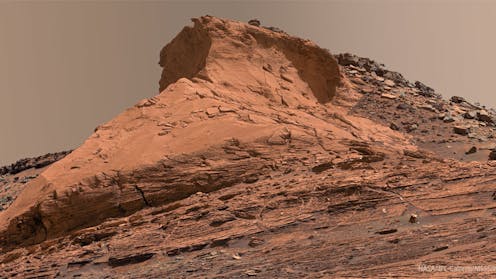
Curious Kids is a series for children of all ages. If you have a question you’d like an expert to answer, send it to CuriousKidsUS@theconversation.com.
Is Mars really as red as people say it is? – Jasmine, age 14, Everson, Washington
People from cultures across the world have been looking at Mars since ancient times. Because it appears reddish, it has often been called the red planet.
The English name for the planet comes from the Romans, who named it after their god of war because its color reminded them of blood. In reality, the reddish color of Mars comes from iron oxide in the rocks and dust covering its surface.
Your blood is also red because of a mixture of iron and oxygen in a molecule called hemoglobin. So in a way, the ancient connection between the planet Mars and blood wasn’t completely wrong. Rust, which is a common form of iron oxide found here on Earth, also often has a reddish color.
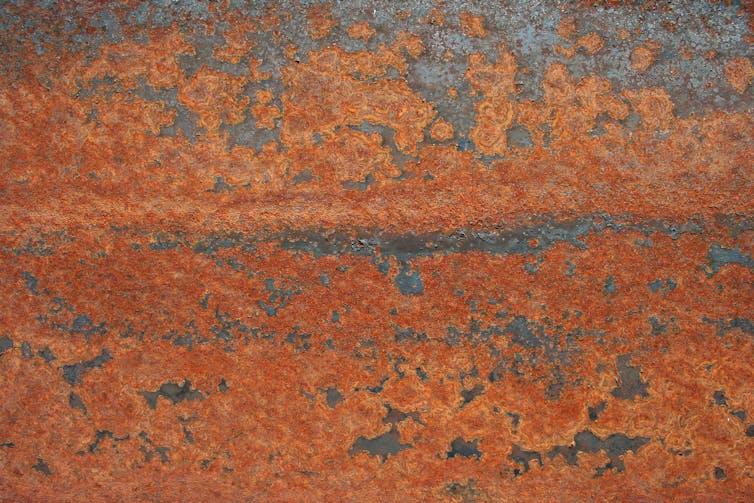
Lars Hammar/Flickr, CC BY-NC-SA
In my current research on exoplanets, I observe different types of signals from planets beyond Earth. Lots of interesting physics goes into how researchers perceive the colors of planets and stars through different types of telescopes.
Observing Mars with probes
If you look closely at pictures of Mars taken by rovers on its surface, you can see that most of the planet isn’t purely red, but more of a rusty brown or tan color.
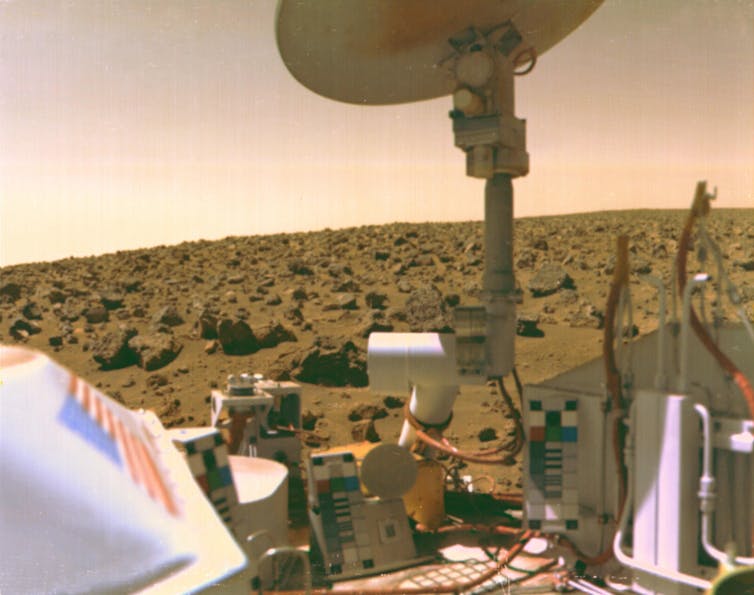
NASA/JPL
Probes sent from Earth have taken pictures showing rocks with a rusty color. A 1976 picture from the Viking lander, the very first spacecraft to land on Mars, shows the Martian ground covered with a layer of rusty orange dust.
Not all of Mars’ surface has the same color. At the poles, its ice caps appear white. These ice caps contain frozen water, like the ice we usually find on Earth, but these ice caps are also covered by a layer of frozen carbon dioxide – dry ice.
This layer of dry ice can evaporate very quickly when sunlight shines on it and grows back again when it becomes dark. This process causes the white ice caps to grow and shrink in size depending on the Martian seasons.
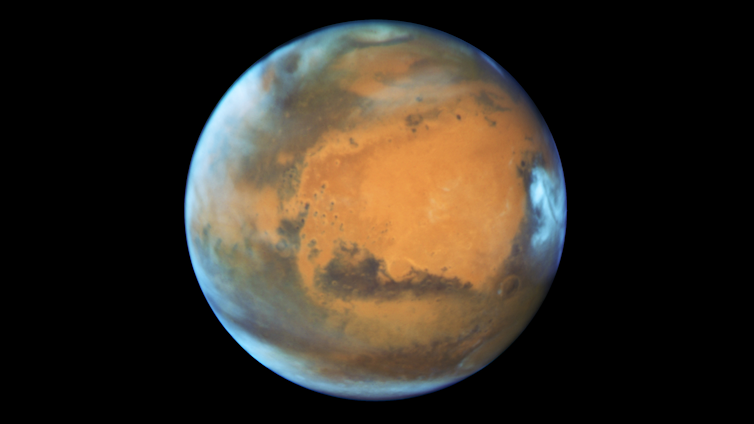
NASA, ESA, Zolt G. Levay (STScI)
Beyond visible light
Mars also gives off light in colors that you can’t see with your eyes but that scientists can measure with special cameras on telescopes.
Light itself can be thought of not only as a wave but also as a stream of particles called photons. The amount of energy carried by each photon is related to its color. For example, blue and violet photons have more energy than orange and red photons.

Inductiveload, NASA/Wikimedia Commons, CC BY-SA
Ultraviolet photons have even more energy than the photons you can see with your eyes. These photons are found in direct sunlight, and because they have so much energy, they can damage the cells in your body. You can use sunscreen to protect yourself from them.
Infrared photons have less energy than the photons you can see with your eyes, and you don’t need any special protection from them. This is how some types of night-vision goggles work: They can see light in the infrared spectrum as well as the visible color spectrum. Scientists can take pictures of Mars in the infrared spectrum using special cameras that work almost like night-vision goggles for telescopes.
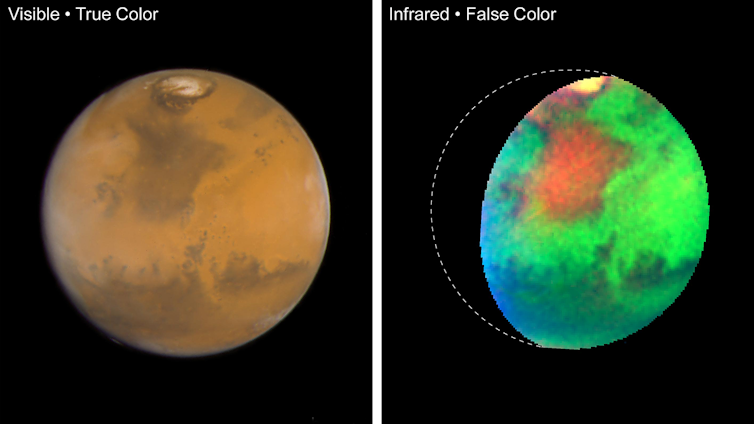
NASA, James Bell (Cornell University), Justin Maki (NASA-JPL), Mike J. Wolff (SSI)
The colors on the infrared picture aren’t really what the infrared light looks like, because you can’t see those colors with your eyes. They are called “false colors,” and researchers add them to look at the picture more easily.
When you compare the visible color picture and the infrared picture, you can see some of the same features – and the ice caps are visible in both sets of colors.
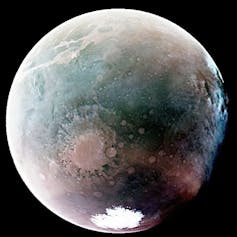
NASA/LASP/CU Boulder
NASA’s MAVEN spacecraft, launched in 2013, has even taken pictures with ultraviolet light, giving scientists a different view of both the surface of Mars and its atmosphere.
Each new type of picture tells scientists more about the Martian landscape. They hope to use these details to answer questions about how Mars formed, how long it had active volcanoes, where its atmosphere came from and whether it had liquid water on its surface.
Astronomers are always looking for new ways to take telescope pictures outside of the regular visible spectrum. They can even make images using radio waves, microwaves, X-rays and gamma rays. Each part of the spectrum they can use to look at an object in space represents new information they can learn from.
Even though people have been looking at Mars since ancient times, we still have much to learn about this fascinating neighbor.
Hello, curious kids! Do you have a question you’d like an expert to answer? Ask an adult to send your question to CuriousKidsUS@theconversation.com. Please tell us your name, age and the city where you live.
And since curiosity has no age limit – adults, let us know what you’re wondering, too. We won’t be able to answer every question, but we will do our best.
![]()
David Joffe receives funding from the NASA Office of STEM Engagement through a grant from the Georgia Space Grant Consortium
